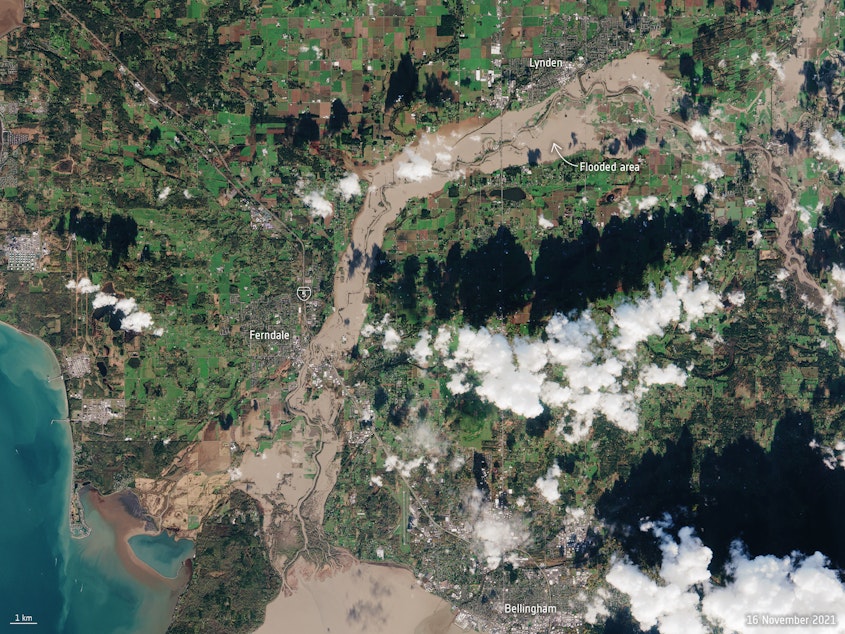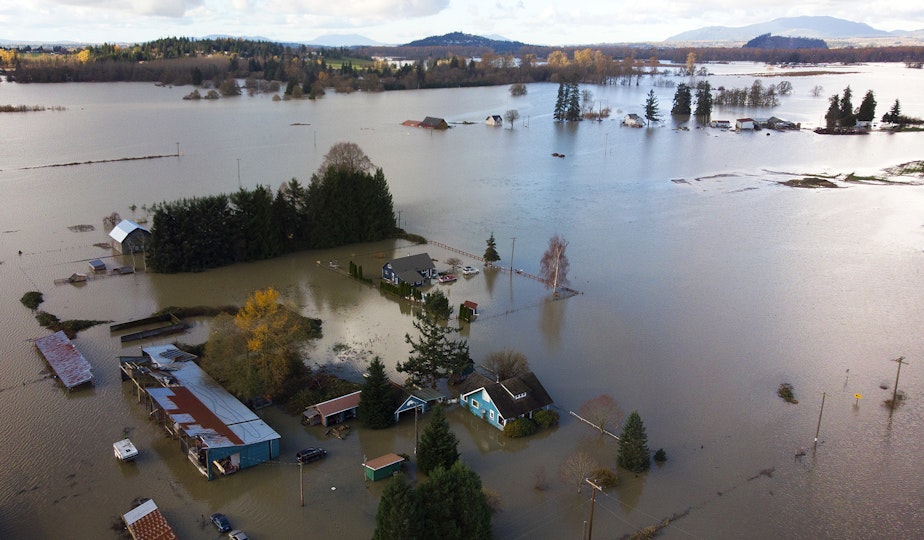Northern Washington tribes fear ‘devastation’ of salmon by extreme floodwaters

Too much water can be dangerous, even for fish.
When a month’s worth of rain hit northern Washington and southern British Columbia in just a couple of days in mid-November, the resulting extreme flows scoured streams and riverbeds. They flushed away gravel and the salmon eggs incubating just below the surface, likely by the millions.
“It’s inevitable that nearly every single Chinook and pink salmon redd [nest] in the Nooksack Basin was destroyed from the extreme flood event,” biologist Tom Chance with the Lummi Natural Resources Department said in an email.
“There have been few flood events ever approaching the devastation of what we witnessed this year,” Chance said.
The extreme flooding, the Nooksack River’s worst on record according to a preliminary assessment from the U.S. Geological Survey, comes just two months after low flows and high temperatures enabled a heat-loving bacteria to proliferate and kill most Chinook salmon in the South Fork Nooksack River.
Perhaps counterintuitively, lower summer flows and extreme precipitation at other times of the year are both predicted under a climate altered by fossil fuel pollution.
“It's all devastating to us as tribal people,” said George Swanaset Jr., director of natural and cultural resources for the Nooksack Tribe. “I mean, we rely on our fish for our diet. It's part of our culture. It's who we are. Without those fish, we don't exist.”
Sponsored
The human toll of the Nov. 14-15 atmospheric river was severe, with major highways and rail connections severed on both sides of the border. Floodwaters swept one man to his death in Whatcom County, while a mudslide killed at least four people in British Columbia.
Washington Gov. Jay Inslee declared a state of emergency in 14 counties. After flooding cut off Canada’s biggest port and forced thousands from their homes, British Columbia Premier John Horgan declared a provincewide emergency.
Though damage assessments are ongoing and time-consuming, the toll of flooding on infrastructure and people is easier to tally than that on fish.
“The funny thing about salmon is we really won't know for another two to five years until this year's cohort of fish come back as adults,” said biologist Catherine Austin with the Skagit River System Cooperative, a project of the Swinomish and Sauk-Suiattle tribes.
Any young fish that couldn’t find a refuge from the November firehose would’ve been swept prematurely downstream.
Sponsored
“Small juvenile salmon are not very strong swimmers,” Austin said.
Biologists may get some indication of the fishy damage next spring by counting young salmon that survived the floods to migrate toward saltwater.
While the toll on salmon might not be fully known for years, Scott Schuyler with the Upper Skagit Indian Tribe says it could be severe.
“Sometimes, depending on how long the flow events are, you could see a 98% loss of spawning in any particular year, depending on the species,” Schuyler said.
With a single salmon laying 2,000 to 5,000 eggs in a nest she digs in river-bottom gravel at the end of her life, the toll in scoured river basins could easily total millions of eggs and young fish.
Sponsored
Still, salmon have evolved over thousands of years to handle floods.
“That dynamic movement of water and sediment continually creates new habitat that's available for fish to colonize, as well as destroying some old habitat and some individuals in the process,” Austin said.
But salmon have survived by having places to hide or ride out destructive flooding in nearby waters. Many of those slow-moving sloughs, side channels and wetlands have been destroyed as farms and towns occupied more of the landscape.
Tribes and wildlife agencies have been restoring side channels and other river habitats to give young salmon more places to hide when their waters flow too fast. Austin says salmon are resilient as long as they have different habitats to turn to under different conditions.

Sponsored
“It's hard to write this off as just a part of the natural process,” Schuyler said. “This atmospheric river, it's not normal.”
Atmospheric rivers are a natural phenomenon, though one that may have been intensified by a changing climate.
“The water got to places in the [Nooksack] valley that it hasn't touched in – I’ve lived here my whole life, and I haven't seen it like this,” Swanaset said.
With November not over yet, this is already the wettest autumn on record in Bellingham and Seattle, according to the National Weather Service.
Nearly 21 inches of rain have fallen on Bellingham since Sept. 1, and nearly 19 inches at Sea-Tac International Airport.
Sponsored
Climate scientists say rainfall is expected to grow more intense as the climate warms and that this month’s events offer a sneak peek of the decades ahead.
Scientists and environmentalists continue to urge a rapid transition away from the use of fossil fuels to prevent a dramatic worsening of floods and other climate-fueled disasters.
On the mainstem of the Skagit River, just south of the Nooksack basin, flooding was lessened by upriver dams. The U.S. Army Corps of Engineers says operators of Ross and Upper Baker dams on the upper Skagit were able to hold back enough water to lower the flood volume downstream by 40%.
“Our hope is that as challenging as an event like that is from a human perspective, we don't anticipate that it'd be quite that bad from a salmon perspective, but it remains to be seen,” Austin said of impacts in the Skagit River.
While the Skagit is the biggest producer of salmon in Puget Sound, much of Washington’s salmon fishing fleet relies on catching Canadian-born salmon as they swim through Washington waters on their way to the mouth of the Fraser River just north of the border.
The atmospheric river behind the recent flooding dumped its heaviest deluges in Canada, leading to what experts are calling a 500-year flood on the Fraser River.
“We know at these levels the gravel moves in the Fraser,” biologist Marvin Rosenau with the British Columbia Institute of Technology told the Vancouver Sun. “The problem is that we just had three or four million salmon lay eggs in the gravel.”
“High water moves sediment, moves pebbles, rocks, cobbles, boulders, and crushes the eggs that are in between them,” Austin said.
Following the flooding, Whatcom County Councilmember Ben Elenbaas said he would keep advocating for more active management of the Nooksack River, including dredging it, to lessen the severity of future floods.
Gravel often builds up in the slower downstream stretches of glacially fed rivers like the Nooksack.
Concerns about the effects of dredging on salmon and a shift toward gravel quarrying on land brought an end to gravel mining in the Nooksack in the 1990s.
Following the mid-November floods, some Whatcom County residents flooded Elenbaas’s Facebook page with comments urging more dredging.
“While I strongly believe dredging is an integral part of managing our river, it isn't the only answer when we see weather like we've seen in the last few days,” the conservative councilmember replied.
Tribal officials say, with Chinook salmon hanging on by a thread in the Nooksack River and elsewhere in Puget Sound, the most important thing is to restore their habitat, not degrade it further.




